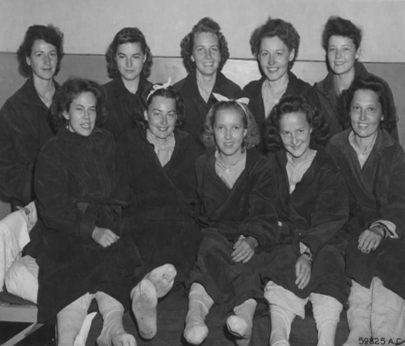

September 20, 2021 by Jenny
Ashcraft
In
November 1943, a C-53 transport plane loaded with 13 medics, 13 flight nurses,
and four aircrew members left
Sicily
headed for
Bari
,
Italy
. Their mission was to transport wounded soldiers to hospitals farther away from
the front lines. A storm, combined with a run-in with German fighter planes,
forced them off course. The airplane crash-landed in Nazi-occupied
Albania
, and the survivors spent nine harrowing weeks trekking 800 miles across
Albania
. They encountered severe challenges and narrowly escaped death. The majority reached freedom on January 9, 1944. Three nurses
who became separated from the group did not get rescued until March 21, 1944.

Aircrew of plane forced down in Albania
On
the rainy morning of November 13, 1943, the crew, medics, and flight nurses from
the 807th Medical Air Evacuation Transport Squadron boarded a
C-53D for the two-hour flight from
Sicily
to
Bari
. Bad weather had grounded the flight for the three previous days, and the
number of injured needing transport to areas with better medical care was
increasing. When the plane left
Sicily
, the skies had cleared, and visibility was good.
As
they neared
Bari
, the skies turned dark. Pilot Charles B. Thrasher saw ominous clouds ahead. They
flew into a violent storm and lost all communications with the ground station at
Bari
. Thrasher decided to ascend above the clouds, but when they reached an altitude
of about 8,000 feet, the wings began to ice up. He quickly descended. Disoriented,
he flew for three and a half hours before spotting a coastline through broken
clouds. Assuming they had reached the western coast of
Italy
, Thrasher and co-pilot Lt. James Baggs began looking for a place to land.
Spotting what appeared to be an abandoned airfield, he began an approach.
Suddenly, tracer bullets began screaming past the aircraft window. Dodging
German fighters, Thrasher ducked into a cloud and flew for another hour through
overcast skies.
With
the plane's fuel was running low, they began looking for a place to land. They eventually saw a flat spot and crash-landed the C-53. Fortunately, nobody was seriously
injured. As the group disembarked the aircraft, members of an Albanian
resistance met them and informed them that they'd crossed the Adriatic Sea and
were in Nazi-occupied
Albania
. The partisans led them to a nearby town, but they had to flee when a German
detachment approached. While walking down a road, three Messerschmitt 109's dive-bombed and strafed the
group as they ran for cover. British officers were operating in the country, and
the partisans let them know that Americans were in the area. One British officer
was assigned to serve as a guide for the group. Later they were met by an
American officer who had been sent into
Albania
to lead them out.

Group of ten of the nurses who escaped
Albania
recover after their ordeal
Early
on, three nurses became separated during a chaotic German attack. A wealthy
Albanian family in the town of
Berat
sheltered the nurses in the basement and later helped them escape disguised as
civilians. It would take that trio nearly five months to reach Allied lines.
They crossed the mountains on donkeys, and when they finally reached the coast,
an Allied torpedo boat skirted them to safety.
For
the next two months, the remaining group walked up to seven hours a day.
Sometimes the snow was knee-deep. Their journey took them across
Albania
's second-highest mountain peak during a raging blizzard. As they journeyed,
kind Albanians shared their meager food and lodging with them. Several times
military officials attempted to extract the group, but German forces intervened
and made rescue impossible. As weeks passed, the nurses' shoes wore thin. The group suffered frostbite,
hunger, dysentery, jaundice, and pneumonia. The nurses demonstrated
determination and grit and gained the admiration of all.

Nurses who escaped
Albania
show their worn shoes
On
January 9, 1944, the group finally made it to the coast and rendezvoused with
rescuers who rowed them out to a British launch, and they were transported to Bari, Italy. The trio of separated nurses arrived at
Otranto
,
Italy
, on March 21, 1944. All of those rescued were forbidden to talk about their
experiences. Officials feared it would endanger the lives of those who helped
them. The 800-mile hike proved the Army nurses' ability to withstand hardships
during the war.
|





